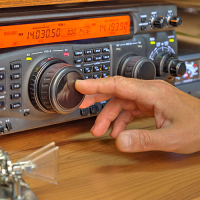Learning bird songs is an art unto itself
 Yellow-billed cuckoo. Donated photo
Yellow-billed cuckoo. Donated photo
Editor’s note: This column first appeared in a May 2009 issue of The Smoky Mountain News.
In the opaque early-morning light outside our bedroom windows, the birds that reside in our woods — or do we reside in their woods? — commence warming up for the day with tentative calls and whistles. The male cardinal seems to take the lead most mornings. Before long, however, the patterns arrange themselves into a tapestry of music.
Throughout the year male and female birds of the same species use various call notes to stay in contact with one another or as signals of alarm. For instance, male and female eastern towhees whistle a call that sounds like “tow-hee.” Therefore the common name.
During the breeding season, the male of the species makes the vocalization we recognize as song in order to establish a breeding territory, attract a female, and warn other males of the same or competing species out of that territory.
The male towhee’s song sounds for all the world like “drink-your-tea.” If you learn the phrases associated with specific calls and songs (“mnemonics” or memory devices), you will be able to identify birds readily whether you actually see them or not.
Some male birds can really sing. Rose-breasted grosbeaks sound like robins that have had music lessons. (Scarlet tanagers, on the other hand, sound like robins with a sore throat.) In my opinion, winter wrens emit the most sensational bird vocalization in the southern mountains: a musical series of bubbling warbles and trills that may last for five seconds or more.
Related Items
There are several bird songs that seem to mystify people. You can hear their songs on a regular basis but never seem to locate the birds. I am invariably queried about these “mystery” songs each year. Two of the most common “mystery” birds of the southern mountains are the yellow-billed cuckoo and the ovenbird.
The yellow-billed cuckoo is a bird that is often heard but seldom seen. Along with the Swainson’s warbler, it is one of the most furtive birds that breeds in Western North Carolina. The cuckoo is known to farmers as the “rain crow” because its hollow, low-pitched “kowp, kowp, kwop, kwop” vocalizations are often sounded just before a summer thunderstorm.
If you must see a yellow-billed cuckoo, sit down near a black cherry tree that contains tent caterpillar nests and watch for movement. You may well have to sit there for a good while — bring your lunch — but you may be rewarded with a fleeting glimpse of the bird described as “a wandering voiced.”
The ovenbird resembles a thrush but is actually a warbler with an orange crown. It nests on the ground in an oven-shaped nest. All day long you can hear their rising “teach-teach-teach” vocalizations without ever seeing the bird except, at best, as a flitting shadow.
Fred Alsop notes in his Birds of the Smokies (1991) that ovenbirds sometimes create a “vocal domino pattern,” when “the singing of one territorial ovenbird often stimulates the adjacent territory holder to proclaim his presence, which induces a third male to announce that he is still on station, which may cause other males to follow suit or hand the challenge back to the original singer.”
There are many CD and cassette guides to bird calls and songs. Although I don’t recommend the two-volume Stokes Field Guide to Birds (1996) by Donald and Lillian Stokes as an everyday field guide, I do recommend Stokes Field Guide to Bird Songs (Time-Warner Audio Books, 1997) by Lang Elliott with Donald and Lillian Stokes. This 3-CD boxed set provides precise call and song recordings of 372 species. The 64-page band location booklet that comes with the set also provides one of the best listing of the “mnemonic” phrases used to recognize bird vocalizations that I am aware of.
(George Ellison is a naturalist and writer. He can be reached at This email address is being protected from spambots. You need JavaScript enabled to view it..)









